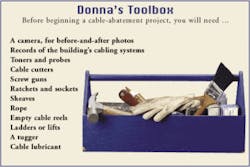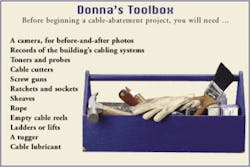Cabling abatement: We know why ... here's how
Have you looked at a business case for establishing a "cabling abatement department" within your installation business? Maybe it is time you did. Possible services could include inspection and inventory of existing telecommunications pathways, spaces, cabling and equipment, and removal of abandoned cable, hardware, and equipment.
There is a lot of old cabling out there that has not been used in years. But even the newer flame-retardant materials will produce toxic gases in a fire, and should be removed if not part of a documented and maintained structured cabling system.
According to Jeff Sargent, senior electrical specialist with the National Fire Protection Association's (NFPA—Quincy, MA; www.nfpa.org) electrical engineering department, "The code requirement is that abandoned cable be removed from 'accessible areas.' This does not mean you have to start ripping out walls." But the level and method of enforcement of the abandoned cabling provisions of the National Electrical Code (NEC) are dependent on state, county, and city permit, and inspection practices for the work site.
Translation: Talk to the authority having jurisdiction (AHJ).
Plan your pull
Regardless of the size or complexity of the project, you will need to be familiar with the current edition of the NEC. With detailed instructions from the owner or designer in hand, survey the project area, and then contact the AHJ for any additional requirements. Here's the plan:
Before-and-after photos. One picture is worth 1,000 words, as the saying goes, but one picture may also save hundreds of thousands of dollars in legal fees. Unless they are driving Bobcats through the interior walls and loading them into waiting roll-offs (my brother-in-law is a general contractor), it is a good idea to take pictures or a video of the existing conditions before beginning the cable abatement. This could save you possible litigation if the owner claims that damage occurred during the cable-removal process.
Material disposal. Review cable prints and records of the building if they are available, and estimate the amount of materials that you will be removing. Plan to safely dispose of the reclaimed materials by using a recycling company or center. Verify that the recycling company will be able to take all of the materials, and at what pace they can accept deliveries.
Tools of the trade. Gather the tools necessary for the job, which may include toners and probes, cable cutters, screw guns, ratchets and sockets, sheaves, rope, empty cable reels, empty bags, ladders or lifts (depending on ceiling height), a "tugger," and cable lubricant.
Check twice, cut once. Caution is imperative, even when you are to remove "all the cabling" in the building—because not all the cable in the building is under the control of the building owner. And you do not want to cut an access provider's cable that feeds the building.
Where to begin
Establish a set of rules (different colored tags or graphics are good) for tagging cables to remove, and cables that are to stay in place or be relocated. Be sure to issue each worker a copy of the rules in their own language.
Want to be certain they remember the rules? Ask them to sign a file copy. If you are not using your "usual" crews, be certain to check for color recognition. One color-blind person with a sharp set of cable cutters can cause mayhem.
As with all cabling projects, begin with the pathways. Cabling is usually installed either in cable tray or conduit, or supported by J-hooks or rings, but it can also be found laying on the ceiling grid and tiles. Each of these support methods presents a unique set of challenges to a cable-abatement crew.
Cables in trays may have been bundled with cable ties. Unless you are removing all the cables in the tray or bundle, it is usually best to cut and remove the ties before beginning to remove the cables. Working from the work-area toward the telecommunications room, cut the cables at the bends and remove the cabling from the straight sections of the tray.
For those sticky situations
Cables on conduit are usually stuck. So, when attempting to remove "stuck" cables from a conduit—either by hand or with a tugger—position a sheave so that the cable swill be pulled straight out of the conduit and not at an angle.
CableFree Loosener from Polywater (www.polywater.com/cablefree.html) is touted to loosen cables that are stuck in conduits due to wax, rust, dirt, soap, etc. But it cannot be used unless all the cables in the conduit are being removed since the re-lubricant will affect the cable jacketing.
But the most time-consuming and tedious removal is when the cables are supported by J-hooks or rings, because the cables must be systematically unthreaded from each one. These supports are usually spaced four to five feet apart along the entire cable run, and may also be attached to the ceiling grid. Pull too vigorously on the cables and up bends the ceiling grid.
For backbone cables, verify cable ends with a toner and probe. Begin at the telecommunications room; remove the connecting hardware with cable cutters. Some connectors will be wall-mounted, usually on plywood, while others will be on equipment racks bolted to the floor and supported by a wall or cable tray. Refer to your detailed instructions to determine whether the racks will be reused or discarded.
Leave sufficient cable slack so that ropes may be tied onto the cables for removal. Several different techniques can be used to attach a pulling rope. Large backbone cables can be attached by using a "cable-pulling grip" or a "cable core hitch."Form a core hitch by removing the cable's outer sheath and weave the conductors through the loop of a bowline knot tied on the end of a rope. You can also use a core hitch to remove horizontal cables.
When removing cable from a vertical shaft, maintain continuous support to avoid cable slippage. A 900-pair riser cable falling several floors could cause serious injury or death to a worker on any of the connecting floors, and could make a huge mess of the ground-floor telecommunications room.
For horizontal cabling, verify cable ends with a toner and probe. Begin at the work-area outlet; remove the connecting hardware from the wall or furniture panel, then from the end of the cable with cable cutters. Start by removing the cable back toward the telecommunications room.
The worst case
Having to remove one cable among many can be the worst-case scenario. For cables that have been installed with home-run conduits, removing one cable should be uneventful if the maximum pulling tension does not exceed 25 lbs./ft. If excess pulling force is required, however, then all the cables in the conduit should be pulled out of the conduit; remove the abandoned cable and pull the others back in, then reterminate and retest for category compliance.
For cables that share a cable tray, J-hooks, or rings, removing one cable will likely require one worker to pull the cable while another locates the correct cable, unthreads, cuts, and removes the freed section.
Donna Ballast is BICSI's standards representative, and a BICSI registered communications distribution designer (RCDD). Send your questions to Donna via e-mail: [email protected]


